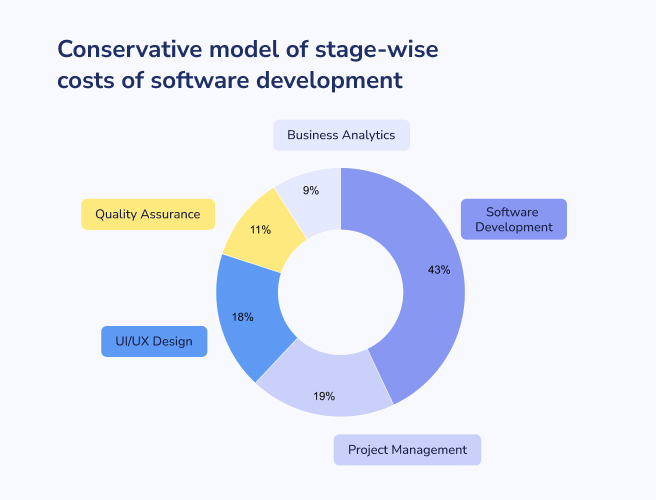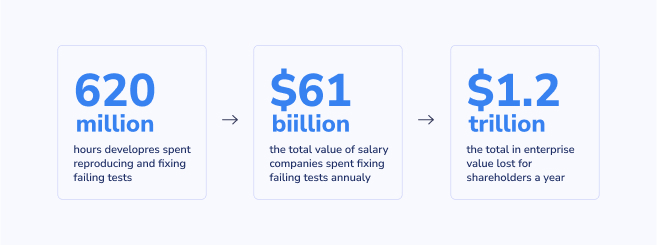<Minimize Costs With Test Automation in Software Development>
While testing is an essential aspect of software development, almost 80% of companies today still use manual methods of testing. The impact and results of testing cannot be undermined. Therefore, companies spend almost 50% of the budget on testing. As per the conservative model of stage-wise costs of software development, QA gets an 11% cost breakdown, while software development takes about 43% of the costs.

However, considering the cons of manual testing, automated testing can be considered to be a dependable and reliable alternative. The software testing vertical, valued at $40 billion in 2020, is growing at a CAGR of 7% for the next few years.
All it requires is enhancing the skills of the testers or outsourcing the job of testing to experts.
It is a common notion that time is money. In other words, time saved is money saved. Automation, by addressing repetitive activities, helps find bugs faster and, therefore, helps save time and, in turn, money.
The obvious question is – how can test automation help reduce software costs? Let’s explore this further here.
Automated Testing: How Costs are Minimized?
There are reasons why top companies in the world today are shifting to automating their testing functionalities. Some of the topmost benefits include making the testing process fast and ensuring minimum delivery delays. Replacing manual testing as a part of agile development can directly and indirectly related to reduced costs.
Pros of automated testing vis-a-vis manual testing include:
#1 Savings on Early Detection of Bugs
Test Automation is a boon as it helps testers discover and uncover bugs during the software development phase. As per statistics, if the right kind of automation tool is used, teams can save up to 75% of the time utilized for bug fixing. Thus, they can save a lot of the company’s time and resources.
The savings come from two sources – (1) testers can find bugs early, and (2) minimize the cost of testing hours on average.
Shockingly, it has been estimated in a study that around 620 million hours are wasted each year by developers in identifying bugs in manual testing processes. On average, this costs about $ 61 billion to companies. After bug identification, another significant 13 hours, on average, are spent on fixing each bug by the developer.

Bugs and errors can prove to be a costly affair. They can result in delays and increase expenses on different resources that are required to identify and fix bugs. Additionally, when bugs are not fixed effectively, the chances of client loss also increase.
Automated testing is an effective way out – not only does it help in detecting errors faster, but it also makes the fixing process easier. Remember, the earlier the bugs are tested, the cheaper it is easy to fix them. Automated unit testing suites automatically keep checking for bugs and failures while developers create the codes. Thus, there’s a shorter feedback loop and fixing the issue can be undertaken at the earliest.
Here’s an example: A few years back, Knight Capital Group launched a trading software system that came with a glitch. It cost the company approximately $40 million, but eventually, the stocks dropped dramatically by almost 75%. Finally, the company was acquired by Getco LLC. All of this happened primarily due to manual testing, where automation was minimally used in the testing phase.
This doesnt mean that companies need to do away with manual testing completely. You need QA specialists to write the test scripts and maintain them.
#2 The Average Cost of Testing Hours
Manual testing has limitations on testing hours; a tester can only test for certain hours. But an automation script can run 24 x 7 and can be reused as many times as need be. As per a white paper titled “Automated Testing ROI: Fact or Fiction,” test automation can run at five times the speed of manual tests. It means an enormous leap in the scope of work at no extra cost.

Software development entails adding new features to existing functionalities, too.
With each new feature, the development team is responsible for ensuring that the feature is free from bugs. Automated testing assists them in improving the quality of features and making them a valuable add-on. This further guarantees that each code written for the newly developed feature is flawlessly tested.
Consider manual testing in its place. Not only will you need to hire more testers as the product starts to become feature-rich with multiple features added, but it also requires more time vis-a-vis automated testing. This is because the testers need to create hundreds of test cases to cover all kinds of possible scenarios. Also, in manual testing, the apps and software need to be tested on multiple devices and browsers.
With test automation, numerous scripts for multiple scenarios can be run parallelly and even during off-work hours.
#3 Faster Tests Means Faster Time-to-Market
Manual testing is not only time-consuming but also a lengthy process. When tests are automated, your projects move a step ahead towards making the project agile. Test automation ensures CD and CI. CD stands for continuous delivery and CI means continuous integration. CI/CD translates into faster delivery. When tests are automated, CI/CD can be easily incorporated into your project.
In Agile frameworks, a two-week sprint scrum involving manual regression tests can take up to 5 days. Automated testing makes this work happen in just about 2 days. Manual testing can, at times, make testing cycles even longer than development cycles. This could severely affect the Agile philosophy.
Check out our unique testing framework
Read moreWay to Reduce Costs with Test Automation
Automated testing helps reduce time-to-market, makes the process agile, and also guarantees a top-quality and flawless product. If you wish to reduce software development costs with test automation, there are two aspects that should be integral to the testing process.
#1 Reduce manual efforts and
#2 Provide faster feedback to the development team
Also, test automation may not suit all kinds of projects. For example, for short-term projects, automation may be expensive. Therefore, start by calculating the automation ROI. Calculate ROI using the formula.

Conclusion
Minimizing costs in software development is an important criterion. When testing methodologies are automated, they can speed up the process, ensure product quality, and help save money.
If you also want to cut down your software development cost, get our automated testing services at WeAreQA. Through our QA automation testing services, we leverage a distinctive framework to deliver unparalleled user experience and ensure product excellence for your offering.



